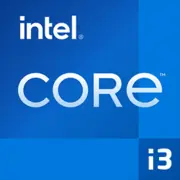Intel Core i3-N305

Intel Core i3-N305: Compact Energy Efficiency for Everyday Tasks
March 2025
In the world of laptops, the balance between performance, battery life, and price remains key. The Intel Core i3-N305 is a processor designed for those seeking a reliable device for work and entertainment without overpaying. Let's explore who this chip is suitable for and what benefits it offers in 2025.
Architecture and Process Technology: A Hybrid Approach for Energy Savings
Codename: Alder Lake N
Process Technology: Intel 7 (10 nm Enhanced SuperFin)
Cores and Threads: 8 cores (Gracemont), 8 threads
Clock Frequencies: Base — 1.8 GHz, max Turbo Boost — 3.8 GHz
Cache: L3 — 6 MB
Integrated Graphics: Intel UHD Graphics (Xe-LP, 32 EU, up to 1.25 GHz)
The Core i3-N305 belongs to the Alder Lake N lineup, which focuses on energy efficiency. Unlike standard hybrid processors with P- and E-cores, this one utilizes only Efficient-cores (Gracemont). This simplified architecture is optimized for background tasks and basic multitasking. The Intel 7 process ensures low thermal output, which is critical for thin laptops.
The integrated UHD graphics are based on Xe-LP architecture with 32 execution units (EU). It supports 4K/60 Hz via HDMI 2.0b and DisplayPort 1.4, but is not designed for serious gaming.
Power Consumption and TDP: Ideal for Portable Devices
TDP: 15 W (configurable by manufacturers to 9 W)
A TDP of 15 W allows the processor to be used in ultrabooks and compact laptops with passive or low-power active cooling. Energy-saving technologies include:
- Intel Speed Shift — dynamic frequency management.
- C-States — disabling unused cores.
- Dynamic Tuning — real-time adaptation to workload.
For comparison, Intel's P-series processors (e.g., i5-1240P) have a TDP of 28 W and require bulkier cooling systems.
Performance: Modest, but Sufficient
Geekbench 6: 1251 (Single-Core), 4659 (Multi-Core)
Real-World Scenarios:
- Office Work: Handles Office 365, Google Workspace, and PDF editors without issues. Working with 10+ tabs in Chrome plus a Zoom call does not cause lags.
- Multimedia: Streaming 4K video, basic photo editing in Lightroom, and editing short clips in 1080p (DaVinci Resolve) is all possible, although rendering will take longer than on a Core i5.
- Gaming: CS:GO — 40-50 FPS on low settings (720p), Genshin Impact — 25-30 FPS (720p). It will suffice for less demanding games (Stardew Valley, Among Us).
Turbo Boost: Under load, the processor briefly boosts to 3.8 GHz but stabilizes at 2.5-2.8 GHz after 2-3 minutes due to TDP limitations. In devices with improved cooling (e.g., laptops with copper heat pipes), turbo mode operates more stably.
Use Cases: Who Is the i3-N305 Designed For?
- Students: Text work, online courses, watching lectures.
- Office Workers: Email, spreadsheets, video conferences.
- Users of Lightweight OS: ChromeOS, Linux (good driver support).
- Digital Nomads: Compact laptops weighing from 1.1 kg with 8+ hours of battery life.
Not Suitable For:
- Professional video editing/3D rendering.
- Modern AAA gaming.
- Heavy multitasking (e.g., running virtual machines and Photoshop simultaneously).
Battery Life: Up to 10 Hours in Moderate Use
Laptops with the i3-N305 (e.g., Acer Swift 1 or Lenovo IdeaPad Slim 3) come equipped with 40-50 Wh batteries, providing:
- 8-10 hours under mixed load (web surfing, YouTube viewing).
- 12+ hours in reading/typing mode.
Energy savings are aided by:
- Hardware AV1 Decoding — reduces the load during streaming video.
- Battery Saver Mode in Windows 11 — limits background processes.
Comparison with Competitors: Competing in the Budget Segment
1. AMD Ryzen 3 7320U (Mendocino):
- 4 Zen 2 cores, Radeon 610M graphics (2 CU).
- Pros: Better graphics for gaming (15-20% faster than UHD).
- Cons: Weaker in multi-threaded tasks (Geekbench 6 Multi-Core ~3800).
2. Apple M1 (in MacBook Air):
- 8 cores (4 Performance + 4 Efficiency), 7-core graphics.
- Pros: Twice the performance, 18 hours of battery life.
- Cons: Starting price of $999, limited compatibility with Windows.
3. Intel Core i5-1235U (previous generation):
- 10 cores (2P + 8E), Iris Xe (80 EU).
- Pros: More powerful in multitasking (Geekbench 6 Multi-Core ~6500).
- Cons: 15 W TDP, but real consumption is higher, poorer battery life.
Pros and Cons of Core i3-N305
Strengths:
- Low-cost laptops ($400-600).
- Cool operation even without a fan.
- Support for modern standards: Wi-Fi 6, PCIe 4.0.
Weaknesses:
- Limited future performance headroom.
- Weaker graphics compared to Ryzen 3 7320U.
Recommendations for Laptop Selection
- Device Type: Ultrabooks (e.g., ASUS Zenbook 14X), budget Chromebooks.
- Minimum Specifications:
- 8 GB RAM (preferably 16 GB for Windows 11).
- 256 GB SSD (NVMe).
- IPS display with a resolution of 1920×1080.
- Additional Features:
- USB-C with charging support.
- Matte screen coating for outdoor use.
Avoid models with HDDs and TN displays as they negate the advantages of the processor.
Final Verdict
The Intel Core i3-N305 is a solid choice for those needing an affordable, lightweight laptop with long battery life. It is ideal for study, office work, and travel, but not designed for professional tasks. If your budget is limited to $500 and gaming and "heavy" programs are not a priority, this processor will be a reliable companion. However, for more intensive workloads, it is better to consider the Core i5 or Ryzen 5.
Basic
CPU Specifications
Memory Specifications
GPU Specifications
Miscellaneous
Benchmarks
Compared to Other CPU
Share in social media
Or Link To Us
<a href="https://cputronic.com/en/cpu/intel-core-i3-n305" target="_blank">Intel Core i3-N305</a>